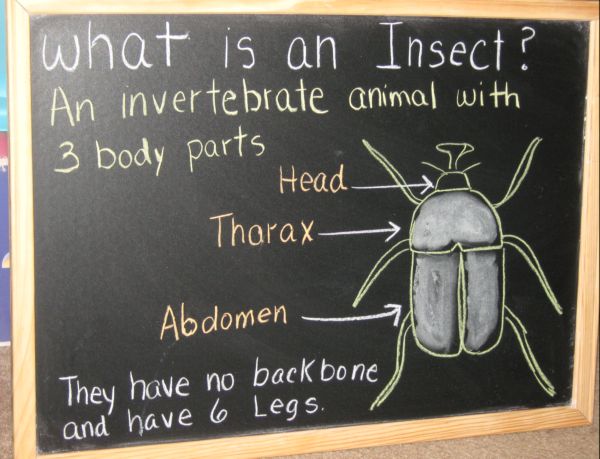Howdy family,
AmeriCorps VISTA Jeffrey Helton here once again to provide you all with some information courtesy of the Grow Appalachia HQ. Our topic this week is bugs, so let’s crawl right in!
In one of my other blog posts, I’ve touched briefly on the weirdness of bugs, and I feel the need to reiterate that… Bugs are weird. Think about it this way; if bugs didn’t already exist, it would probably take the warped mind of a very gifted science fiction author to invent them. (I mean, heck, some bugs sort of serve as templates for many of the unearthly creatures that we already see in movies.) But despite their alien nature, bugs are things of science fact, and here in the real world, they play a big role in the delicate ecosystem of every garden.
Bug Recognition
If you’re anything like me, you want to know everything that there is to know about bug recognition so that you’ll be able to identify all your future pest problems and live happily ever after. Also, if you’re like me, you’re probably overwhelmed by the prospect. The fact of the matter is that there are at least 950,000 known varieties of bugs in the world. (Some scientists estimate that the total number, including bugs that aren’t yet undiscovered, is anywhere between 2 million and 30 million.)
It’s a disappointing truth, but there’s literally no way that you’re going to be able to recognize them all, so you shouldn’t even fret that much about memorization. Even a great extension agent might not be able to immediately recognize more than a couple handfuls of insects. Recognition is a skill that you will build over time, year by year, bug by bug, and ultimately, you’ll only have to worry about those bugs particular to your area. Don’t be overwhelmed. Just be patient and willing to let your knowledge blossom!
Some recognition tips:
- Learn to separate insects into big categories like beetles, crickets, butterflies, etc. (Sites like this one will help you in the process of narrowing down the bugs you encounter in your garden. Pay attention to things like color and shape. You can even narrow it down by the state that you live in.)
- Keep in mind that just because something is creepy and crawly, that doesn’t mean that it is a bug. It might be a centipede, a worm, a spider, a mite, etc.
Image courtesy of http://preschool2prek.blogspot.com/
- Seek help online. To do this, you might want to snap a photo of a bug and write down some observations about it–anything that might help someone else narrow it down, like your location, what sort of plants the bug hangs out on, etc. (This is one great site for getting help in identifying bugs.)
- At the risk of sounding like a broken record… Talk to your extension agent! Even if they don’t know everything, they know how to research, and they have resources that will surely aid you.
The Good, the Bad, the Bugly
I recently did some work on our newsletter about fermentation and talked a bit about good bacteria and bad bacteria. Like bacteria, bugs don’t necessarily sound so great, but the picture is more complicated than that. There are awesome varieties that you will want in your garden, and there are other bugs that will devastate your garden.
These bad pests can ruin your hard work by feasting on your plants or by leaving their bodily waste on your plants. Here in Berea, some of the biggest pests that we encounter are Colorado potato beetles, Japanese beetles, and blister beetlese. Even creatures like raccoons and deer fall under the “pest” umbrella. (Raccoons often urinate on plants, so look out for them!)
Beneficial insects, on the other hand, might improve your garden by eating pest insects, by pollinating flowers, and by breaking down decaying matter. Some beneficial insects that you might come across include ladybugs, which eat aphids; hunting wasps, which destroy pest eggs; lacewings, which feed on numerous pests; and spiders, which, despite frightening most people, are harmless–at least in their “garden variety” forms.
As I mentioned before, a garden is a delicate ecosystem, so it can be tough to balance out the “culture” of bugs in your own garden. Here are some closing tips on achieving a more ideal bug set-up:
- Follow the principles of Integrated Pest Management, which dictate that you should begin your pest management with low-impact methods like picking or hosing off pests. Don’t move to chemical methods of management unless it is an absolute necessity. Even picking and hosing pests can accidentally devastate beneficial bugs.
- Use crop rotation techniques and try not to plant a vegetable in the same spot that a closely-related vegetable was planted the season before. By adjusting the layout of your garden, you’re throwing curveballs at pests (and diseases!) just as they’re getting comfortable.
- Plant buckwheat and other cover crops to attract beneficial bugs. You can also research what particular flowers beneficial bugs are attracted to and then plant some of those in your garden. (If you do this, make sure that these bugs also have a source of water, which should be taken care of easily with a small birdbath or something similar.)
- Plant trap crops. These are crops that will draw harmful pests away from your more vulnerable and valuable crops. (For example, Japanese beetles often plague rose gardens, but they are more enchanted by geraniums, so if you plant some near your roses, you can reduce some of the damage that they will do!)
If you have any other awesome bug tips, leave them in the comments below. Until next time!
-Jeffrey




Leave A Comment